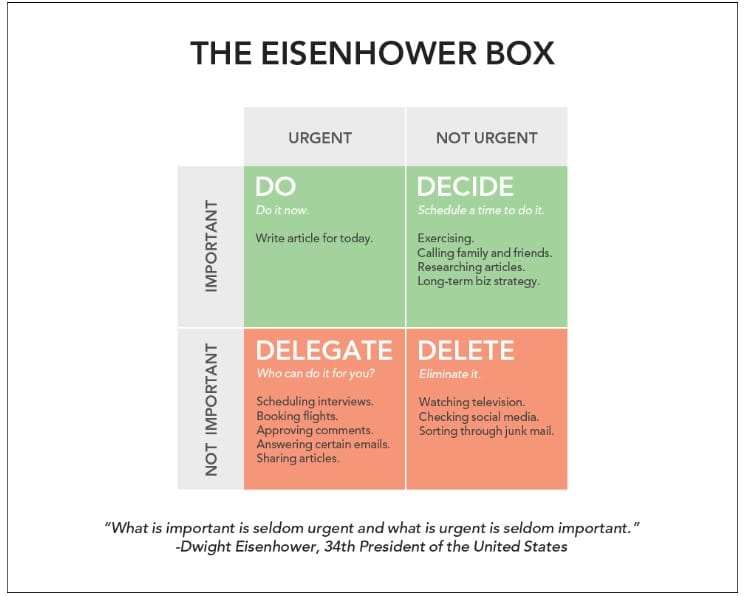As a PR pro, you are a navigator of chaos steering through a whirlwind of clients, campaigns, and continuous communication. It’s a world where time is a precious commodity, and the demands can often feel overwhelming.
Your daily to-do list is a dynamic one, with multiple clients vying for attention, tight deadlines, and unexpected crises to manage. To make sense of it all and do your best, you need ways to optimize your productivity and master time management.
Keep reading to learn four vital tips that’ll help you gain greater control of your schedule, enhance efficiency, and reclaim your work-life balance.
1. Prioritize tasks effectively
Better productivity is synonymous with better prioritization. The order in which you choose to tackle your tasks—based on urgency, difficulty, or importance—is crucial to your productivity.
Here are a few quick tips to improve your prioritization as a PR pro:
- Urgent vs. important: Start by categorizing your tasks into four buckets i.e. urgent and important, important but not urgent, urgent but not important, and neither urgent nor important. Put them on a 2-axis graph and you have yourself the Eisenhower Matrix (see below), inspired by President Dwight D. Eisenhower. Your tasks are sorted into four quadrants i.e. Do First (urgent and important), Schedule (important but not urgent), Delegate (urgent but not important), and Eliminate (neither urgent nor important). Looking at it, you can allocate your time wisely. Focus your immediate attention on tasks that are both urgent and important.
- Time blocking: Allocate specific blocks of time for different types of tasks. Dedicate, for example, the morning to high-priority, mentally demanding work and the afternoon to emails and meetings. Stick to your schedule religiously.
- Daily to-do lists: Create a to-do list for each day, but keep it short and focused on your top priorities. Three to five key tasks are usually manageable.
- The two-minute rule: If a task can be completed in two minutes or less, such as following up on a pitch, do it immediately. This prevents small tasks from piling up.
- Leverage technology: If you aren’t already, consider using task management apps like Trello or Asana to visually organize and track your tasks.

Ultimately, maintain some capacity to be flexible. After all, PR is dynamic, and requirements can shift rapidly — so, stay agile and adjust priorities if needed.
2. Leverage time management tools and techniques
While you don’t need to track every second of your work day, knowing how you’re spending your working hours helps you organize your schedule for optimal productivity. And for this, in addition to the task management apps mentioned above, take your pick from the plethora of time management tools available today:
- Time tracking software: Tools like Toggl or Clockify help you monitor how you spend your work hours, providing insights into where time is well-spent and where it’s wasted. In case you’re managing a team of PR professionals or other colleagues, using employee monitoring software to analyze their productivity, daily activities, and timesheets can help keep everyone on track.
- Calendar apps: Use digital calendars like Google Calendar or Microsoft Outlook to schedule tasks, meetings, and reminders. Sync them across devices for easy accessibility.
- Task lists and apps: Platforms like Todoist or Wunderlist let you create to-do lists, set priorities, and receive notifications to stay on top of tasks.
Besides time blocking (discussed above), here are a couple of tried-and-true time management techniques you can use to optimize your productivity:
- The Pomodoro Technique: Work in short, intense bursts (usually 25 minutes) followed by a short break. This method is known to enhance concentration and prevent burnout.
- Batching: Group similar tasks together and tackle them in dedicated time blocks. For instance, handle all your emails during specific periods rather than sporadically throughout the day.
By combining the right tools with effective techniques, you can master time management skills, stay organized, minimize distractions, and watch your productivity soar.
3. Master the art of delegation
When your plate is full, avoid trying to tackle everything yourself. This kind of multitasking can not only lead to reduced productivity but also eventually cause burnout. Knowing when and how to delegate tasks effectively is a skill that can transform your productivity as a PR professional.
Here’s how:
- Identify delegatable tasks: Start by recognizing which tasks can be delegated. These can be ones that don’t require your unique expertise or immediate attention, such as data gathering, research, or routine administrative work.
- Select the right team members: Choose colleagues with the skills and capabilities to handle the delegated tasks. Consider their strengths, workload, and availability.
- Communicate clearly: When delegating, provide crystal-clear instructions. Clearly outline the task’s objectives, expectations, deadlines, and any specific guidelines. Encourage questions and open communication.
- Trust your team: Trust is at the core of delegation. Empower your team to take ownership of the tasks. Micromanaging defeats the purpose of delegation and wastes your time.
- Set checkpoints: Establish checkpoints or milestones for ongoing progress checks. This ensures that the task is on track and allows for timely adjustments if needed.
- Offer support: Be available for guidance and support, but avoid taking control of the task. Your role is to facilitate, not to do the work for them.
- Review and feedback: Once the task is completed, review the results and provide constructive feedback. Acknowledge their efforts and give kudos.
- Learn from experience: Delegation is a skill that improves with practice. Reflect on each delegation experience to refine your approach and identify areas for improvement.
- Delegate strategically: Consider your team’s long-term growth. Delegate tasks that provide learning opportunities for your team members and help them develop new skills.
Delegation not only lightens your workload but also empowers your team, fosters collaboration, and frees you to focus on high-value tasks that demand your expertise. It’s essential for boosting productivity in the fast-paced PR landscape.
4. Create a structured daily routine
Unpredictability is the norm in PR, so crafting a structured daily routine might seem counterintuitive. However, it’s precisely this structure that can provide the stability and efficiency needed to navigate your workload. Here’s how to create a daily routine that works for you as a PR professional:
- Start with a morning ritual: Begin your day with a consistent morning routine. Whether it’s exercise, meditation, or a hearty breakfast, this ritual sets a positive tone for the day ahead.
- Prioritize your most important task (MIT): Identify your most critical task for the day—the one that will move the needle the most. Tackle it first, when your energy and focus are at their peak.
- Use time management techniques: The ones discussed above—time blocking, batching, and Pomodoro. Make sure to implement these to schedule workload and breaks.
- Manage email and communication: Dedicate specific time slots for checking and responding to emails and messages. Avoid constantly switching between tasks to stay focused.
- Review and plan: At the end of each day, review your accomplishments and plan for the next day. This ensures you start the day with a clear agenda.
Here’s a sample routine to get a better understanding:
Morning (9:00 AM – 12:00 PM)
- 9:00 AM – 9:30 AM: Morning Ritual and Priority Setting
- 9:30 AM – 10:30 AM: Media Monitoring and News Analysis
- 10:30 AM – 11:30 AM: Content Creation (Press Releases, Articles, Blog Posts)
- 11:30 AM – 12:00 PM: Email and Communication Management
- Lunch Break (12:00 PM – 1:00 PM)
Afternoon (1:00 PM – 5:00 PM)
- 1:00 PM – 2:00 PM: Client Meetings and Updates
- 2:00 PM – 3:00 PM: Social Media Management and Engagement
- 3:00 PM – 4:00 PM: Project Coordination and Team Collaboration
- 4:00 PM – 5:00 PM: Review and Planning for the Next Day
Put simply, building a structured daily routine provides a framework for managing your PR responsibilities efficiently while maintaining a healthy work-life balance.
Wrapping up
By prioritizing tasks, harnessing the right tools and techniques, mastering the art of delegation, and creating a structured daily routine, you can not only level up your productivity but also achieve a healthier work-life balance. Embrace these tips, adapt them to your unique context, and watch your efficiency soar as you navigate the dynamic landscape of PR.








